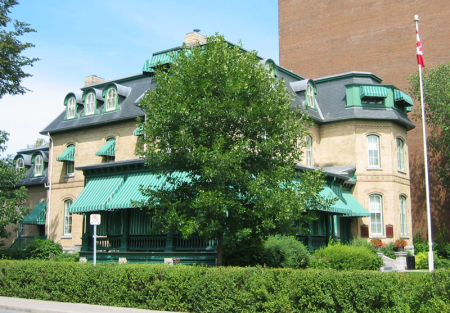Thursday, July 24th, 2025 dawned sunny and hot as our Museum Club undertook its walking tour of Sandy Hill and its guided tour of Laurier House. In response to the extreme heat predicted for the day, our organizer, Callie Foster, a summer co-op student, and our walking tour lead, Ben Weiss, had arranged to split the group offering a walking tour both before and after the Laurier House tour, so some of our participants could avoid the hottest part of the morning, if they chose to do so. As such, Ben and Callie had to do the walking tour twice in the heat.
Our Parks Canada guide at Laurier House, located at 335 Laurier Avenue East, explained that the house had been built by John Leslie, a prosperous Ottawa jeweler, who moved his family into it in1879. When Wilfred Laurier became Prime Minister in 1896, he needed a suitable place to live in Ottawa, there being no official residence provided by the government at that time. As Laurier was not wealthy, a group of friends came together to purchase the house for $9,500. The Lauriers moved into the house in the fall of 1897 and lived there until their deaths, Wilfred in 1919 and his wife Zoé in 1921. The Lauriers had no children and upon her death Zoé left the house to their friend and then Liberal leader William Lyon Mackenzie King. King was also not a rich man, but again friends stepped forward to pay for the extensive renovations he requested. King moved into the home in January 1923, living there until his death in 1950. He bequeathed the house and most of its contents to the people of Canada and it opened as a museum in 1951.
Our tour of Laurier House, three storeys with lots of stairs, lasted an hour and our guide pointed out many interesting features of the house and kept us all entertained with stories about the Lauriers and King. Laurier House is free to visit, though there is a charge for the guided tour, which I believe is well worth it. They also serve a High Tea and there is a small gift shop in the Visitor’s Centre around the corner on Chapel Street.
The walking tour, led by Ben Weiss, lasted about 1.5 hours and went east along Laurier Avenue East to Charlotte Street, then back along Daly Avenue and on to Wilbrod Street, to Laurier Avenue again and return to Laurier House, though we did veer off a few times to look at specific structures and learn of their historic significance. Due to its proximity to the centre of government and commerce, Sandy Hill became the community of choice for the political and business elite of early Ottawa. It remains a favoured location for embassies and official residences, many of which Ben pointed out as we walked along. This included the Russian embassy at 285 Charlotte Street, where we encountered a small demonstration in support of Ukraine. Ben quickly related the story of the Soviet defector Igor Gouzenko, which in September 1945 started the Cold War, and the fire that destroyed the original building in January 1956 with a delay in fighting the fire caused by the Soviet officials who refused entry to the burning building by the Ottawa Fire Department.
Apart from Laurier and King, a number of other Prime Ministers lived or grew up in Sandy Hill. We passed by houses or apartments which had been lived in by John A. MacDonald, Charles Tupper, Lester Pearson and John Diefenbaker. Two leaders of the New Democratic Party also lived in Sandy Hill, Tommy Douglas and Ed Broadbent. Ben pointed out the former homes of many other famous Canadians including Sandford Fleming, Billy Bishop, Dan Aykroyd, Archibald Lampman, and many many others.
We relaxed in the shade at Strathcona Park, that Ben explained had been through a long transition from swamp, to cow pasture to rifle range and golf course and finally to an extravagant park, since scaled down.
Though Ben did his best to point out many of the significant buildings and tell their stories and those of their generations of occupants, the history of Sandy Hill is so rich that a single walking tour can do little more than scratch its surface. Fortunately, Ben has agreed to return in the summer of 2026 to lead a Sandy Hill Walking Tour Part 2.






